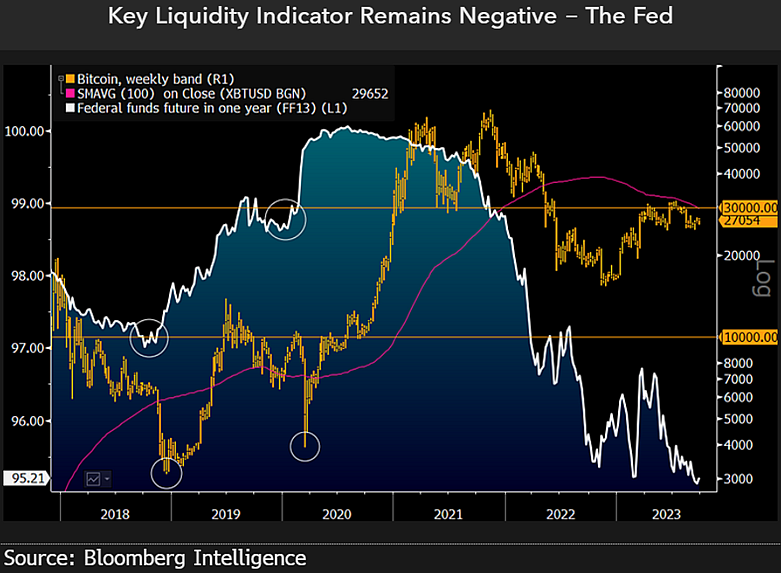
Crypto Crisis Imminent, Warns Bloomberg's Mike McGlone, Despite Bitcoin's Surge To $28,000
October 2, 2023On October 2, Mike McGlone, Commodity Strategist at Bloomberg, took to social media X (formerly known as Twitter) to express his concerns about the state of the crypto market.
Despite Bitcoin’s (BTC) recent rise, McGlone highlighted a disturbing trend and raised the possibility of a cryptocurrency recession.
Factors Behind Crypto Market’s Recession Risk
McGlone pointed out the concept of “positive beta vs. negative liquidity” and its implications for the cryptocurrency market.
Bloomberg’s senior Macro Strategist suggested that the weakness observed in the third quarter of 2023 could be either a temporary blip in the recovery or a sign of an impending recession.
According to McGlone, the latter scenario is more likely, given that most risk assets experienced gains in 2023 but have since rolled over into the new quarter.
The strategist also drew attention to the actions of central banks worldwide, noting that many are tightening their monetary policies despite signs of contraction in the United States and Europe.
Additionally, McGlone highlighted the ongoing property crisis in China, which carries deflationary implications. He argued that the Bloomberg Galaxy Crypto Index’s (BGCI) relative underperformance may reflect changing conditions for an asset class that has thrived in a zero-interest-rate environment.
Drawing historical parallels, McGlone mentioned the swoons in Bitcoin’s price preceding Federal Reserve (Fed) pivots, implying that cryptocurrencies could serve as leading indicators for broader market liquidity. McGlone suggested that a revival of liquidity may be necessary to support the crypto market.
Bitcoin Maximalist Identifies Key Factors For Remarkable Market Growth
In addition to McGlone’s forecast, increased regulatory scrutiny and implementing stringent regulations by governments and regulatory bodies can significantly impact the cryptocurrency market.
The United States regulatory bodies have been actively cracking down on the crypto market, causing delays in what was expected to be a bullish run. Lawsuits filed in 2023 and signals of continued regulatory actions by the US Securities and Exchange Commission (SEC) have created uncertainty and restrictive regulations that can dampen investor sentiment and contract the market.
Moreover, economic factors contribute to concerns about a potential recession in the digital asset ecosystem. Cryptocurrencies are interconnected with the broader economic landscape, meaning global recessions, monetary policy changes, inflation, or deflation can affect the cryptocurrency market, potentially leading to a recession.
On the other hand, some view the largest cryptocurrencies as safe havens during significant declines in the world’s largest economies. Bitcoin maximalists, including “The Bitcoin Therapist,” assisted by Artificial Intelligence (AI), have identified key factors necessary for Bitcoin and the overall market to achieve remarkable growth.
These factors include mass adoption, global economic uncertainty, institutional investment, limited supply, increased transaction volume, technological improvements, regulatory clarity, positive market sentiment, halving events, and a global currency crisis.
While progress has been made in factors such as global economic uncertainty, limited supply, increased transaction volume, technological improvements, and halving events, achieving mass adoption, institutional investment, regulatory clarity, positive market sentiment, and a global currency crisis are still pending.
The strategist’s remarks underline the cautious sentiment surrounding cryptocurrencies despite recent positive movements in Bitcoin’s price.
McGlone’s analysis suggests that the cryptocurrency market may face significant headwinds due to changing economic conditions, central bank policies, and potential liquidity challenges.
Featured image from Shutterstock, chart from TradingView.com
Source: Read Full Article



